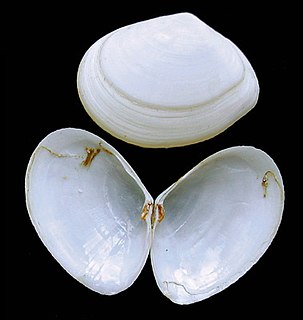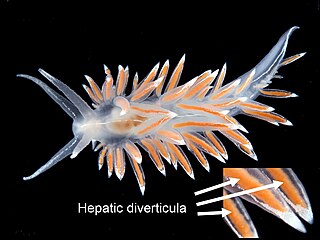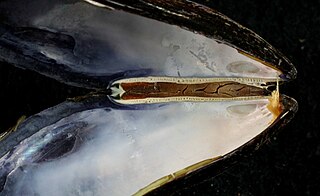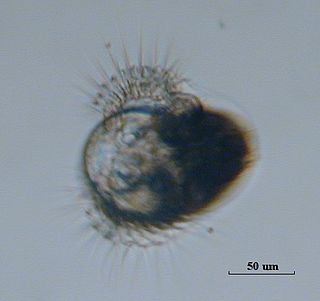 W
WAbductin is a natural elastic protein that is found in the hinge ligament of bivalve mollusks. It is unique as it is the only protein in nature with compressible elasticity. It is similar to elastin and resilin, but amino acid analysis reveals that it has high concentrations of glycine and methionine.
 W
WThe adductor muscles are the main muscular system in bivalve mollusks, i.e. in clams, scallops, mussels, oysters, etc. In many parts of the world, when people eat scallops, the adductor muscles are the only part of the soft parts of the animal which are eaten. Adductor muscles leave noticeable scars or marks on the interior of the shell's valves. Those marks are often used by scientists who are in the process of identifying empty shells to determine their correct taxonomic placement.
 W
WThe beak is part of the shell of a bivalve mollusk, i.e. part of the shell of a saltwater or freshwater clam. The beak is the basal projection of the oldest part of the valve of the adult animal. The beak usually, but not always, coincides with the umbo, the highest and most prominent point on the valve. Because by definition, all bivalves have two valves, the shell of a bivalve has two umbones, and two beaks.
 W
WA bivalve shell is part of the body, the exoskeleton or shell, of a bivalve mollusk. In life, the shell of this class of mollusks is composed of two hinged parts or valves. Bivalves are very common in essentially all aquatic locales, including saltwater, brackish water, and freshwater. The shells of bivalves commonly wash up on beaches and along the edges of lakes, rivers, and streams. Bivalves by definition possess two shells or valves, a "right valve" and a "left valve", that are joined by a ligament. The two valves usually articulate with one another using structures known as "teeth" which are situated along the hinge line. In many bivalve shells, the two valves are symmetrical along the hinge line—when truly symmetrical, such an animal is said to be equivalved; if the valves vary from each other in size or shape, inequivalved. If symmetrical front-to-back, the valves are said to be equilateral, and are otherwise considered inequilateral.
 W
WA byssus is a bundle of filaments secreted by many species of bivalve mollusk that function to attach the mollusk to a solid surface. Species from several families of clams have a byssus, including the pen shells, the true mussels and the false mussels: the Pinnidae, the Mytilidae and the Dreissenidae.
 W
WA ctenidium is a respiratory organ or gill which is found in many mollusks. This structure exists in bivalves, cephalopods, Polyplacophorans (chitons), and in aquatic gastropods such as freshwater snail and marine snails. Some aquatic gastropods possess one ctenidium known as monopectinate and others have a pair of ctenidia known as bipectinate.
 W
WAs applied to mollusks, the New Latin term diverticulum is an anatomical feature. The term is most often encountered in the plural form as "diverticula", "hepatic diverticula", or "digestive diverticula", which are anatomical terms for organs which are visible from the outside of the body in a clade of sea slugs known as aeolid nudibranchs, marine opisthobranch gastropod molluscs.
 W
WA hinge ligament is a crucial part of the anatomical structure of a bivalve shell, i.e. the shell of a bivalve mollusk. The shell of a bivalve has two valves and these are joined together by the ligament at the dorsal edge of the shell. The ligament is made of a strong, flexible and elastic, fibrous, proteinaceous material which is usually pale brown, dark brown or black in color.
 W
WA lunule is an anatomical feature which is found in the exterior surface of the shells of some species of clams, bivalve mollusks, as for example in the family Veneridae and in the genus Ascetoaxinus.
 W
WA siphon is an anatomical structure which is part of the body of aquatic molluscs in three classes: Gastropoda, Bivalvia and Cephalopoda.
 W
WA style, sometimes referred to as a crystalline style, is a rod made of glycoprotein located in the midgut of most bivalves and some gastropods which aids in extracellular digestion. It consists of a protein matrix coated with digestive enzymes secreted by the style sac in the animal's stomach. When feeding, its projecting end is scraped against the stomach wall and abraded, thus releasing the enzymes.
 W
WThe umbo is the vaguely defined, often most prominent, highest part of each valve of the shell of a bivalve or univalve mollusk. It usually contains the valve's beak, the oldest point of the valve, and its degree of prominence and its position relative to the hinge line are sometimes helpful in distinguishing bivalve taxa. The umbo forms while the animal is a juvenile, and radial growth subsequently proceeds around that area. The umbo is situated above the hinge line. In those bivalves where the umbones do not protrude, as is the case for example in some mussels, the umbones can nonetheless usually be readily identified by examining the concentric growth lines of the shell.
 W
WA veliger is the planktonic larva of many kinds of sea snails and freshwater snails, as well as most bivalve molluscs (clams) and tusk shells.